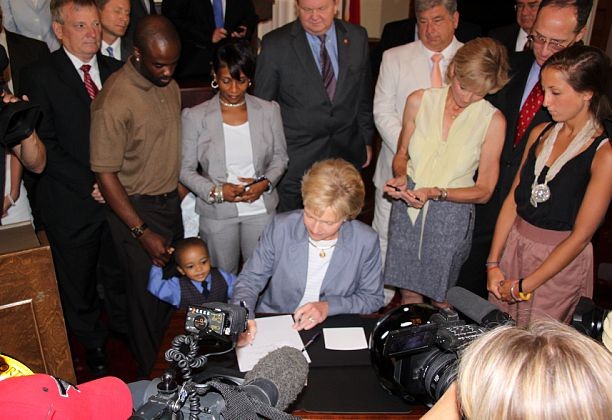On June 16, 2011, North Carolina governor Bev Perdue signed the Gfeller-Waller Concussion Awareness Act, adding the state to the list of twenty-four states* that have enacted strong youth sports concussion safety laws since the first such law went into effect in Washington state in May 2009.
Looking on as Governor Perdue signed the bill were the families of Matt Gfeller, a 15-year old, two-way starter (linebacker and offensive guard), as a sophomore at R.J. Reynolds High in Winston-Salem, who died in August 2008 after suffering a catastrophic brain injury during a game, and Jaquan Waller, a JH Rose High School football player who died after suffering two head injuries in a week that same year.
Key provisions
The law, which covers all middle schools and high school interscholastic sports, provides as follows:
- Training program. The law requires the Matthew A. Gfeller Sport-Related Traumatic Brain Injury Research Center at the University of North Carolina - Chapel Hill, in consultation with the North Carolina Medical Society, the North Carolina Athletic Trainers Association, the Brain Injury Association of North Carolina, the North Carolina Neuropsychological Society, the North Carolina High School Athletic Association, Inc. and the Department of Public Instruction to develop an athletic concussion safety training program for use by coaches, school nurses, school athletic directors, volunteers, student-athletes and parents, which shall include:
- Written information detailing the recognition of the signs and symptoms of concussions and other head injuries;
- A description of the physiology and the potential short-term and long-term effects of concussions and other head injuries; and
- The medical return-to-play protocol for post-concussion participation in interscholastic athletic activities.
- Education and consent. The state Board of Education is charged with adopting eligibility rules for middle and high school athletes, providing for:
- all coaches, school nurses, athletic directors, first responders, volunteers, and students who participate in interscholastic sport, and the parents of student-athletes, receive on an annual basis a concussion and head injury information sheet; School employees, first responders, volunteers and students must sign the sheet and return it to the coach before they can participate, including tryouts, practices, or competition; Parents must sign the sheet and return it to the coach before their child can participate.
- Immediate removal from play; no same day return to play (RTP). If a student exhibits signs and symptoms consistent with concussion, the athlete shall be immediately removed and shall not be allowed to return to play or practice that day.
- Written clearance before RTP. Athletes will not be permitted to return to play until they have been evaluated by and received written clearance from a
- licensed physician with training in concussion management;
- a neuropsychologist with such training;
- a licensed athletic trainer;
- a physician's assistant; or
- a nurse practitioner.
- Emergency action plan. Each school is required to develop an emergency action plan to deal with serious injuries and acute medical conditions in which the condition of the patient may deteriorate rapidly. The plan must be:
- in writing and include a delineation of roles, methods of communication, available emergency equipment, and access to and plan for emergency transport;
- reviewed by a license athletic trainer;
- approved by the school principal;
- distributed to all appropriate personnel;
- posted conspicuously at all athletic venues; and
- reviewed and rehearsed annually by all licensed athletic trainers, first responders, coaches, school nurses, athletic directors, and volunteers.
Turning point on safety
In an interview with MomsTeam's Brooke de Lench, Matt Gfeller's father, Bob, called the law's signing a "very bright day for the state of North Carolina [and] for the future safety of all student athletes, girls and boys alike. We feel both great about the new law and blessed that it is part of Matt's legacy to those players who follow him onto the field."
"Each component of the law is an important turning point for player safety," Gfeller said. "The key difference between before [Matt's death] and after is the simple fact that these ideas are no longer just guidelines, they are now the law, to be followed 100%. This insures that the right people do the right things for the student athletes from pre-season to game time. Very important and powerful."
Asked what he wanted other parents to know about student athlete safety, Gfeller (pictured with his wife, Bev, and the Waller family) said, "Parents need to be more knowledgeable about the issues and the risks and the facts. ... to be better informed about symptoms, prevention and treatment of concussions. Parents need to know that no question is a bad question when it comes to the safety of their child in sports." 
His advice: "Be bold, study and get the answers you think you need."
* As of January 2, 2012, the number of states that have enacted sports concussion safety laws stands at 31 and the District of Columbia.
Revised September 1, 2011; revised January 2, 2012








